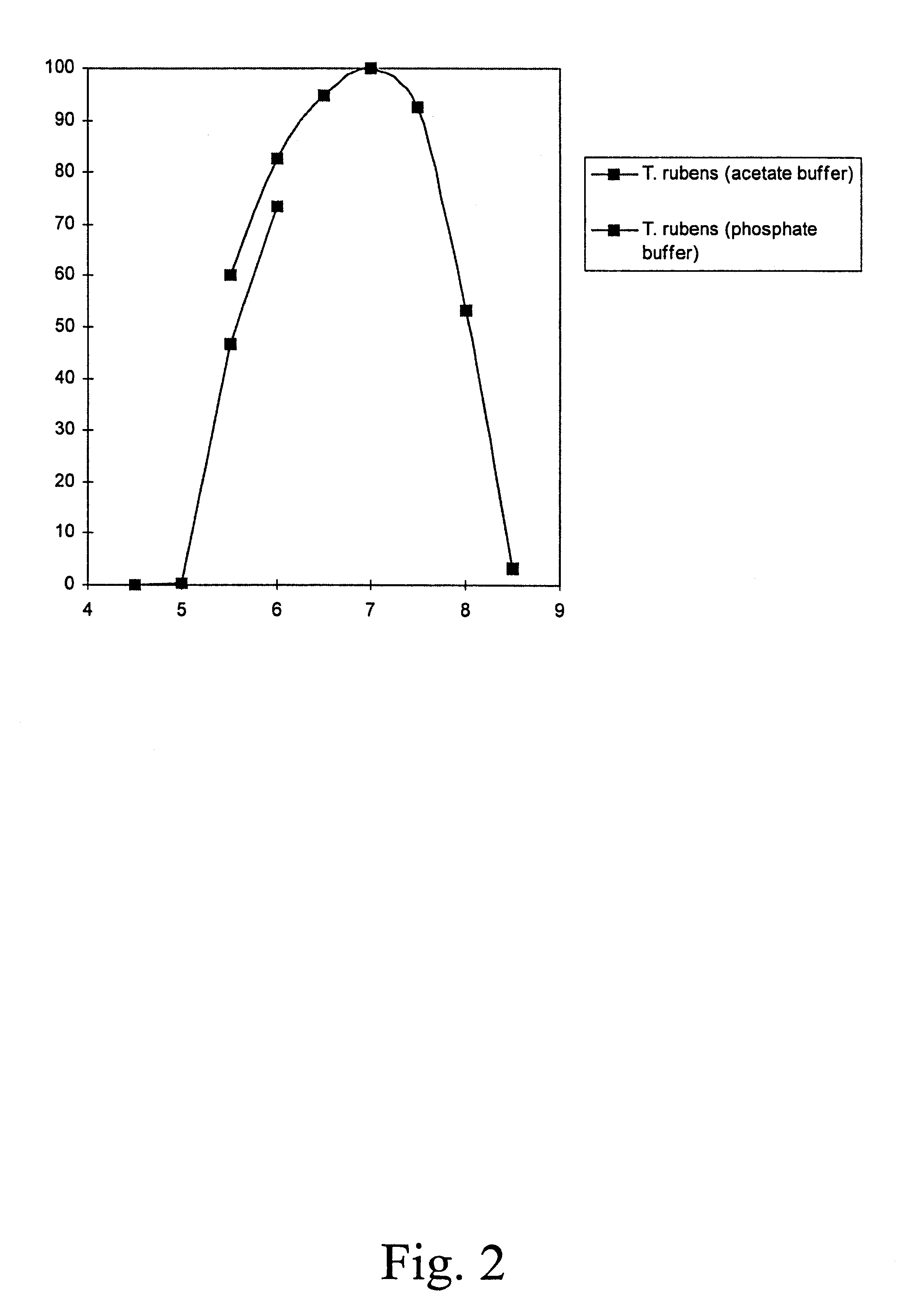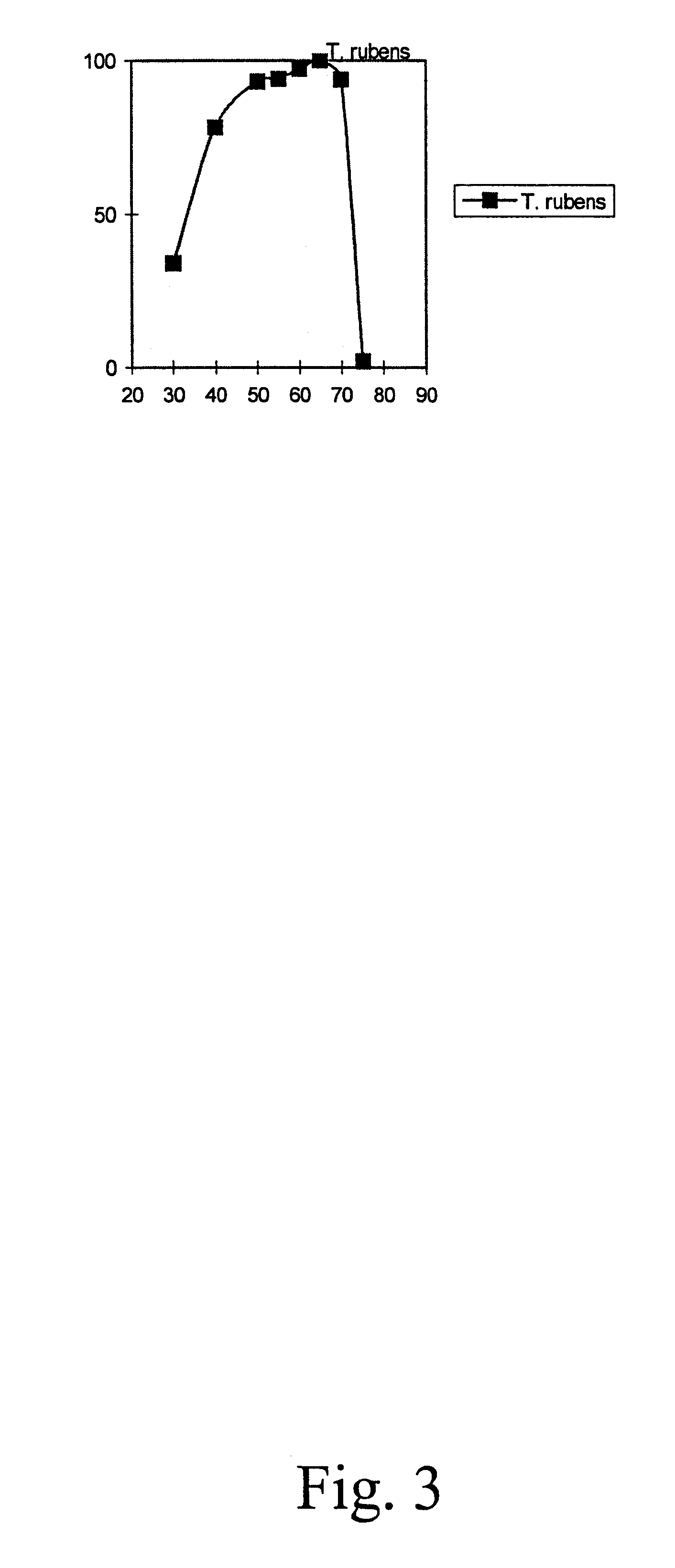Polypeptides having glucanotransferase activity and nucleic acids encoding same
a technology of glucanotransferase activity and polypeptide, which is applied in the direction of transferases, detergent compounding agents, biological water/sewage treatment, etc., can solve problems such as polymorphism within populations
- Summary
- Abstract
- Description
- Claims
- Application Information
AI Technical Summary
Problems solved by technology
Method used
Image
Examples
example 1
Preparation of a Thermus rubins Glucanotransferase Gene Probe
The primers gt-1 and gt-5 were designed based on the other published glucanotransferase genes and used in a polymerase chain reaction (PCR) with genomic DNA from Thermus rubins. The above-mentioned glucanotransferase genes have been identified in glucanotransferases from:
Solanum tuberosum, Accession number (AC) q06801: J. Biol. Chem. 268, 1391-1396 (1993); Clostridium butyricum NCIMB7423, AC 137384: Microbiology 143(10), 3287-3294 (1997); Escherichia coli K-12, AC p15977: Mol. Microbiol. 2, 473-479 (1988); Homo sapiens, AC p35573: J. Biol. Chem. 267, 9294-9299 (1992); Haemophilus influenzae, AC p45176: Science 269, 496-512 (1995); Streptococcus pneumoniae, AC p29851: Cell 31, 327-336 (1982); Synechocystis SP. AC p72785: DNA Res. 3, 109-136 (1996); Thermus aquaticus, AC AB016244: Appl. Environ. Microbiol. 65, 910-915 (1999); and Borrelia burgdorferi, AC AE001127: Nature 390, 580-586 (1997).
PCR Primers:
gt-1: 5'-GGI GAY ATI C...
example 2
Cloning of the Thermus rubens Glucanotransferase Gene
Using the inserted fragment as a Thermus rubens glucanotransferase probe, Southern hybridization was performed on digested genomic DNA from Thermus rubins to select convenient restriction enzymes for generating subclones. A hybridized KpnI and SacII fragment of 1.8 kb and a hybridized ScaI and Kpn fragment of 1.6 kb were selected for glucanotransferase gene subclones. Thermus rubins genomic DNA was digested with KpnI-SacII and ScaI-KpnI, individually. Then these two fractionated fragments were cut out from agarose gels and cloned into pBluescript SK(-). These two libraries were made by transforming the ligated clones into E. coli DH12S cells. Colony lift was performed on transformants of these two libraries using Hybond-N.sup.+ membranes (Amersham Pharmacia Biotech, Japan), and then hybridized to the DIG-labeled probe. Positive colonies were picked and inserts were checked by PCR. Plasmids from selected colonies were prepared and ...
example 3
Construction of Expression Vector
By using the primers ruben-Nco and ruben-Xba, which included a NcoI and XbaI restriction enzyme site, respectively, the whole glucanotransferase gene was amplified from Thermus rubins genomic DNA. Cutting the PCR-amplified fragment with NcoI and XbaI allowed directionally cloning into a pBAD / Myc-His A vector digested with NcoI and XbaI. The resulting vector pFuku-ruben (shown in FIG. 1) produced the polypeptide of the invention after transformation in TOP 10 E. coli and induction with arabinose.
Primers:
ruben-Nco: PCR primer (forward) for amplification of the Thermus rubens glucano-transferase gene. Underlined nucleotides introduce the NcoI site:
5'-GCGCCATGGAACTCCAACGCGCTTTTG-3' (SEQ ID NO:5)
ruben-Xba: PCR primer (reverse) for amplification of the Thermus rubins glucano-transferase gene. Underlined nucleotides introduce the XbaI site:
5'-GCGTCTAGATCAAGCGCGCTGGCTGGCCTC-3' (SEQ ID NO:6)
pBAD / Myc-HisB with the complete Thermus rubins glucanotransferase enc...
PUM
| Property | Measurement | Unit |
|---|---|---|
| temperature | aaaaa | aaaaa |
| temperature | aaaaa | aaaaa |
| temperature | aaaaa | aaaaa |
Abstract
Description
Claims
Application Information
 Login to View More
Login to View More - Generate Ideas
- Intellectual Property
- Life Sciences
- Materials
- Tech Scout
- Unparalleled Data Quality
- Higher Quality Content
- 60% Fewer Hallucinations
Browse by: Latest US Patents, China's latest patents, Technical Efficacy Thesaurus, Application Domain, Technology Topic, Popular Technical Reports.
© 2025 PatSnap. All rights reserved.Legal|Privacy policy|Modern Slavery Act Transparency Statement|Sitemap|About US| Contact US: help@patsnap.com



